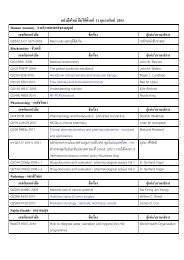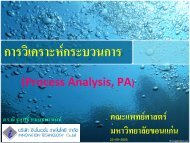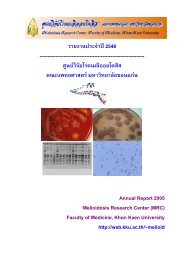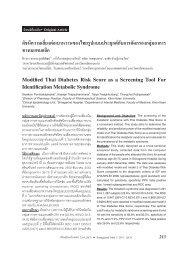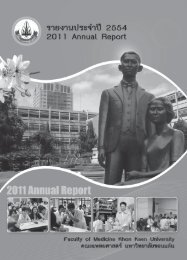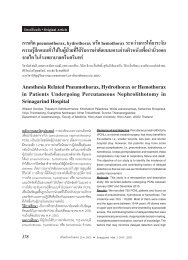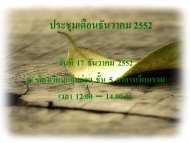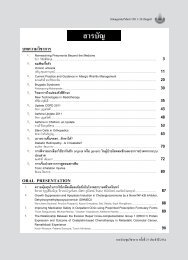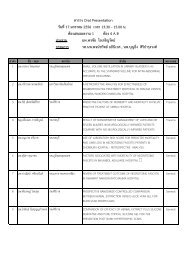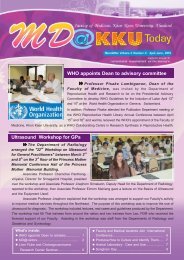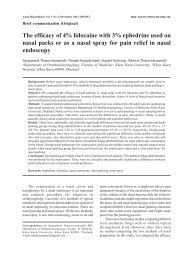Radiation dose from CT scanning: can it be reduced?
Radiation dose from CT scanning: can it be reduced?
Radiation dose from CT scanning: can it be reduced?
Create successful ePaper yourself
Turn your PDF publications into a flip-book with our unique Google optimized e-Paper software.
20P. Trinavarat, et al.Appendix <strong>Radiation</strong> protection glossary<strong>Radiation</strong> <strong>dose</strong>*General term applied to the quant<strong>it</strong>y of radiation received by a body where the radiationinteracts.Absor<strong>be</strong>d <strong>dose</strong>*The quant<strong>it</strong>y of energy imparted to un<strong>it</strong> mass of matter (such as tissue or organ) byionizing radiation. Un<strong>it</strong> Gray (Gy). 1 Gy = 1 joule per kilogram.Equivalent <strong>dose</strong>*Different types of radiation have different radiation qual<strong>it</strong>ies resulting in different degreeof biological damage. Equivalent <strong>dose</strong> is obtained by multiplying the Absor<strong>be</strong>d Dose bya <strong>Radiation</strong> Weighting (qual<strong>it</strong>y) factor. Un<strong>it</strong> Sieverts (Sv).Effective <strong>dose</strong>*Different tissues/organs have different degree of sens<strong>it</strong>iv<strong>it</strong>y to radiation stochasticeffect. Effective <strong>dose</strong> is obtained by multiplying the Equivalent Dose by TissueWeighting Factor. The resulting quant<strong>it</strong>y <strong>can</strong> <strong>be</strong> used to express detriment to the wholebody as a summation of several organ <strong>dose</strong>s. Un<strong>it</strong> Sieverts (Sv). CollectiveCollective effective <strong>dose</strong>* It is derived <strong>from</strong> summing the individual effective <strong>dose</strong>s w<strong>it</strong>hin an exposure population.This quant<strong>it</strong>y has <strong>be</strong>en used to assess overall detriment and therefore as an aid todecision making techniques in optimizing radiation protection.Tissue weighting factor* The factor takes account of the different sens<strong>it</strong>iv<strong>it</strong>ies of different organs and tissues forinduction of probabilistic effects <strong>from</strong> exposure to ionizing radiation (principally inductionof <strong>can</strong>cer).Stochastic effect*It represents radiation harm for which there is no threshold. Even the smallest quant<strong>it</strong>yof ionizing radiation exposure <strong>can</strong> <strong>be</strong> said to have a fin<strong>it</strong>e probabil<strong>it</strong>y of causing aneffect, and this effect <strong>be</strong>ing e<strong>it</strong>her <strong>can</strong>cer in the individual or genetic damage.Deterministic effect* It descri<strong>be</strong>s ionizing radiation induced damage where a <strong>dose</strong> threshold exists and forwhich the sever<strong>it</strong>y of damage increases w<strong>it</strong>h increasing <strong>dose</strong> above that threshold.Examples will include radiation burns, hair loss, cataracts, and radiation sickness.Linear <strong>dose</strong> response* Linear <strong>dose</strong> response in radiation protection relates to the zero-threshold model thatpredicts that every small add<strong>it</strong>ion of radiation exposure contributes to an increment inthe probabilistic / stochastic effect. The response relies on the assumption that evenone photon has the abil<strong>it</strong>y to cause an ionization event in DNA which may in<strong>it</strong>iate<strong>can</strong>cer (or other genetic effect).<strong>CT</strong>DI (<strong>CT</strong> <strong>dose</strong> index)** The <strong>CT</strong>DI represents the radiation <strong>dose</strong> of a single <strong>CT</strong> slice and is determined usingcylinder acrylic phantoms of a standard length w<strong>it</strong>h diameters of 16 cm and 32 cm.Un<strong>it</strong> mGy.<strong>CT</strong>DI w(weighted <strong>CT</strong>DI) ** The <strong>CT</strong>DI wreflects the weighted sum of two-thirds peripheral <strong>dose</strong> and one-third central<strong>dose</strong> in a 100-mm range in acrylic phantoms.<strong>CT</strong>DI v(volume <strong>CT</strong>DI) ** The <strong>CT</strong>DI vis defined as <strong>CT</strong>DI wdivided by the <strong>be</strong>am p<strong>it</strong>ch factor. It is the most commonlyc<strong>it</strong>ed index for modern MD<strong>CT</strong> equipmentDLP (<strong>dose</strong> length product) ** The DLP is the <strong>CT</strong>DI vmultiplied by the s<strong>can</strong> length in centimeters. Un<strong>it</strong> mGy cm.* http://www.ionactive.co.uk/glossary_search.html (access Septem<strong>be</strong>r 9, 2010)**http://www.medscape.com/viewarticle/572551 (access Septem<strong>be</strong>r 9, 2010)References1. Berrington de Gonzalez A, Mahesh M, Kim KP, et al.Projected <strong>can</strong>cer risks <strong>from</strong> computed tomographics<strong>can</strong>s performed in the Un<strong>it</strong>ed States in 2007. ArchIntern Med. 2009; 169: 2071-7.2. Sodickson A, Baeyens PF, Andriole KP, Prevedello LM,Naqfel RD, Hanson R, et al. Recurrent <strong>CT</strong>, cumulativeradiation exposure, and associated radiation-induced<strong>can</strong>cer risks <strong>from</strong> <strong>CT</strong> of adults. Radiology. 2009; 251:175-84.3. Hall EJ, Brenner DJ. Cancer risks <strong>from</strong> diagnosticradiology. Br J Radiol. 2008; 81: 362-78.4. Brenner DJ, Hall EJ. Computed tomography-anincreasing source of radiation exposure. N Engl J Med.2007; 357: 2277-84.5. L<strong>it</strong>tle MP. Risks associated w<strong>it</strong>h ionizing radiation.Br Med Bull. 2003; 68: 259-2756. Balter S, Hopewell JW, Miller DL, Wagner LK,Zelefsky MJ. Fluoroscopically guided interventionalprocedures: a review of radiation effects on patients’skin and hair. Radiology. 2010; 254:326-41.7. Bor D, Olgar T, Toklu T, Caglan A, Onal E, Padovani



